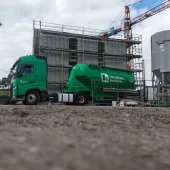Concrete gravity foundations in offshore wind farms

First published in the December 2013 issue of Quarry Management as Sound Waves
A compelling reason for concrete gravity foundations playing a major role in delivering offshore wind capacity is that they are installed with minimal underwater noise, as they do not require the piling that steel solutions do. Andrew Minson, executive director of The Concrete Centre, explains.
In UK waters, a significant – and perhaps the greatest – impact associated with the installation of offshore wind farms is the significant level of underwater noise and sound pressure waves resulting from piling operations. The hammering of steel piles can produce underwater sound and pressure waves at levels high enough to cause death, damage and displacement of marine mammals and some fish species; including fish eggs and larvae. International legislation now reflects the serious consideration of these possible effects.
As wind farms move into deeper water these offshore environments may also provide larger potential for more extensive sound wave propagation, with less potential for attenuation than in near-shore environments. Both steel jacket and tripod foundations require piling to secure the ‘feet’ to the seabed, resulting in multiple noise emissions per foundation. Therefore, increased noise impacts are a reality that will require closer scrutiny. More rigorous consenting procedures are now in place due to the implementation of marine environmental legislation such as the Habitats Directive and the Marine Strategy Framework Directive.
Any concrete gravity base foundations (CGBFs) that require ground-preparation works will generate some noise associated with the dredging activity. However, evidence from marine aggregate extraction operations demonstrates that dredging noise levels are barely detected above those associated with general vessel navigation. Also, the extent and duration of noise from seabed preparation will be very much lower in comparison with marine aggregate extraction areas, due to the small area of seabed dredged and the time-limited window of dredging.
Research findings
The single largest source of anthropogenic underwater noise is recorded from percussive piling activity associated with foundation installation. Pile driving generates very high sound pressure levels that are relatively broad-band (from 20Hz to more than 20kHz) and these interact with auditory ranges of the sensitive species. Observed effects on marine mammals include displacement, shifts in migration patterns, and strandings. Fish species experience similar effects and there is evidence that larger fish with larger swim bladders may experience greater effects.
The most recent research into noise generated by marine aggregate dredgers was funded through the Marine Aggregate Levy Sustainability Fund. Based on this report, the noise associated with any foundation pit preparation required is likely to be heard at distances of less than a kilometre and the effect of noise disturbance on fish is likely to be negligible. The fact that successful commercial fisheries coincide with marine aggregate licence areas implies that fish either acclimatize to dredger noise, or rapidly return to areas from which they may be displaced.
Conclusion
CGBF solutions present a large positive effect when considering near and far-field underwater noise impacts, as no piling or hammering is required for installation, allowing mitigation of one of the major environmental impacts associated with offshore wind farm construction. This is both beneficial to the environment and mitigates a significant planning/programme risk.
- Subscribe to Quarry Management, the monthly journal for the mineral products industry, to read articles before they appear on Agg-Net








